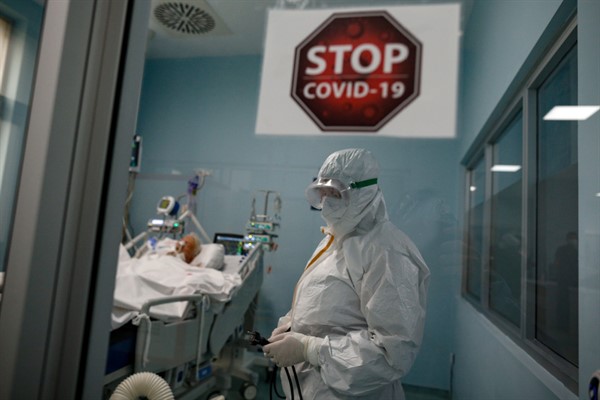The world has just passed an important anniversary. A year ago, on the eve of 2020, a municipal office in Wuhan, China, reported that 27 people in the city had come down with a strange and unidentified “viral pneumonia.” The next day, the World Health Organization picked up on the report and reached out to the Chinese government for more information. No one realized at the time how significant this new pathogen—later named SARS-CoV-2, the virus that causes COVID-19—would become. One year later, it has changed the world in unimaginable ways.
The past year has seen nearly 86 million cases of COVID-19 and more than 1.8 million deaths. In the immediate aftermath of the virus’ global spread, economies around the world were sent reeling, with the World Bank estimating that the global economy would shrink by 5.2 percent by the end of 2020. More than 20 million people lost their jobs in the United States alone, where unemployment reached 14.7 percent in April—the highest level of unemployment since the Great Depression. Just last month, the United Nations warned that the loss of jobs and income threatens to push a billion people—nearly one-eighth of the world’s population—into extreme poverty, erasing decades of progress on poverty reduction in an instant. Reports of discrimination and xenophobia, against people of Asian descent, refugees and other groups inaccurately perceived as being more likely to spread COVID-19, are on the rise and hampering disease control efforts, according to the United Nations. The pandemic has also strained governments at all levels and impaired the work of international organizations.
In better news, the world has also learned a lot over the past year—although some countries much more than others—about how to deal with the coronavirus and manage the worst pandemic in a century. At the start of 2020, scientists had never seen this coronavirus before, and did not even know if it could be transmitted from person to person; within months, they confirmed that the virus is transmitted via respiratory droplets and aerosols. Throughout the year, we saw how governments that took quick, decisive and science-based actions were able to effectively stop COVID-19’s spread. Perhaps most impressively, scientists developed not one, but two highly effective coronavirus vaccines in less than a year, with a third—from AstraZeneca and the University of Oxford—now being distributed in the U.K. This is the shortest time that it’s ever taken to create a vaccine for a disease, beating the previous record, the mumps vaccine, by a full three years.

